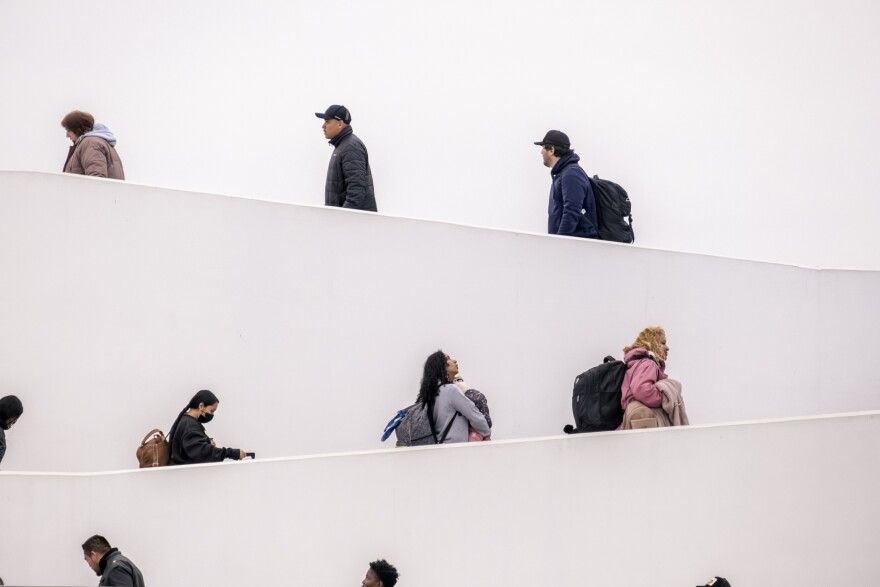The chaotic scenes of migrants rushing the border that many feared would accompany the end of Title 42 did not materialize on Friday.
Instead, the first day of the post-Title 42 era looked a lot like the last several days at the border. A limited number of asylum seekers who had appointments through the U.S. Customs and Border Protection’s (CBP) mobile app were allowed to enter, while hundreds of migrants who crossed without appointments were kept in a makeshift migrant camp between two border walls in San Ysidro.
This anti-climactic scene played out throughout the entire southern border, according to federal officials.
“We continue to encounter high levels of noncitizens at the border, but we did not see a substantial increase overnight or an influx at midnight,” Blas Nunez-Neto, an assistant secretary for border and immigration policy at the Department of Homeland Security, told reporters Friday morning.
No one knows for sure why fewer people showed up than expected. Advocates are speculating that it might be due to the Biden administration’s new asylum restrictions.
In anticipation of the end of Title 42, a pandemic-era rule that allowed border officials to turn away asylum seekers without a court hearing, the Biden administration introduced new asylum restrictions.
The new rules are meant to encourage migrants to use the mobile app, called CBPOne, to schedule appointments before entering the United States. Migrants without appointments are more likely to be turned away. They must prove they applied for asylum and were denied in another country before pursuing asylum in the United States.
The preference for mobile app users has been apparent all week. Those with appointments form an orderly line in the El Chaparral border crossing and are allowed to enter into the United States at 7 a.m. and 12 p.m. every day.
Friday morning’s line had migrants from Russia, Armenia, Afghanistan, Haiti, Mexico and Central America.
Critics of CBPOne point out that the application rewards migrants with newer smartphones and strong WiFi connections instead of the most vulnerable migrants. In the first three months of the app’s launch, 44% of appointments went to Russian nationals, who are relatively more affluent than Latin American asylum seekers, according to data from the Mexican government.
This disparity was on display Friday.
Mexican asylum seekers walked from their migrant shelters to the border crossing, carrying all of their belongings in grocery bags and donated suitcases. Meanwhile, Russian asylum seekers were observed being dropped off by Uber drivers and kept their belongings in suitcases.
Regardless of how they got there, all of them were happy to finally have an opportunity to pursue asylum in the United States.
“I am a little nervous, but very happy that I finally have my appointment,” said Lisete Lopez, an asylum seeker from the Mexican state of Guerrero.
Lopez waited three months for an appointment. She’s traveling with her four young children.
The experience has been different for those at the CBP's makeshift camp for those who crossed into the U.S. without appointments via the mobile app.
Migrants in that camp sleep outside with little protection from the cold and rain. The only food they receive from border officials is two granola bars each day. As many as 400 people share a single toilet.
“That was the worst night of my life,” said Andres, a Colombian asylum seeker, about sleeping through the rain Wednesday.
Biden’s new asylum restrictions have drawn the ire of immigrant advocates. Several organizations, including the ACLU and the Center for Gender & Refugee Studies (CGRG), filed a federal lawsuit to block the restrictions.
“People fleeing persecution have a legal right to seek asylum, no matter how they reach the border,” said Melissa Crow, director of litigation at CGRS. “Our asylum was designed to project people fleeing imminent threats to their lives, who do not have the luxury of waiting for an elusive appointment.”
Their lawsuit argues that seeking asylum in a transit country, like Mexico, is not safe.
Six Mexican states are currently in a Level 4, “Do Not Travel” advisory, according to the U.S. Department of State. The border state of Baja California is under a Level 3, “Reconsider Travel,” because of crime and kidnapping concerns.















